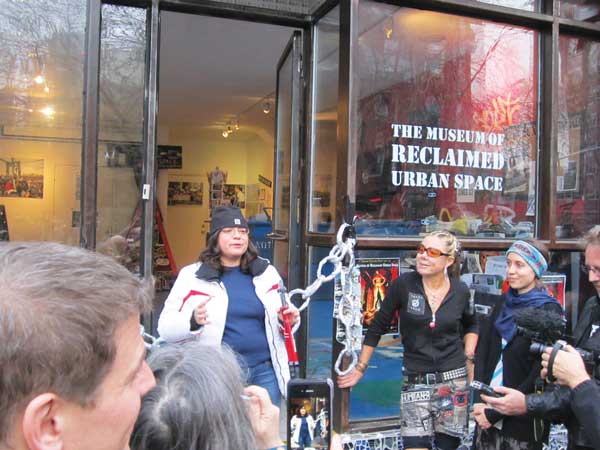
BY LINCOLN ANDERSON | Could it be the ultimate irony?
Among those snapping photos at the opening ceremony for the Museum of Reclaimed Urban Space on Saturday was none other than the landlord who “reclaimed” an entire East Village tenement from his tenants so that he could convert it into a five-story mansion for himself and his family.
“It’s an interesting little museum,” a smiling Alistair Economakis remarked to an acquaintance as the landlord photographed the action outside MoRUS as City Councilmember Rosie Mendez used a bolt cutter to snip open a chain of links fashioned from silver duct tape.
Following the chain-cutting, Economakis ducked inside the Avenue C museum, then quickly re-emerged and briskly walked off along the avenue, heading downtown.
Very possibly, he was headed back to 47 E. Third St., where he and his wife, Catherine, now reside, along with their three small children. The couple waged a lengthy landlord-tenant fight to clear the building. They first offered the tenants buyouts, but not all of them accepted the offer, instead choosing to fight in court to keep their apartments.
But the Economakises had the right to take over the building under the owner-occupancy law, provided they would, in fact, live there for a few years after they gained control of the entire premises. As a result, the building became known as the “Mass Eviction Mansion.”
Ultimately, though, they didn’t evict anyone. Seeing the writing on the wall, and unable to afford a continuing court battle, the holdouts threw in the towel and took buyouts of around $70,000 apiece.
According to photographer Marlis Momber, who was on hand at Saturday’s opening, Alistair Economakis is at the museum pretty often.
“Deep pockets,” she added.
Indeed, MoRUS faces a stiff challenge in paying its rent, which is $1,600, for its storefront space in C-Squat near E. 10th St. Mendez has pledged to allocate $3,500 to the museum, good for two months rent, but those funds haven’t even come through yet. The museum needs patrons, although, despite Momber’s comment, it wasn’t immediately clear if Economakis is among them.
At the opening, Laurie Mittelmann, one of the museum’s co-directors, when asked about Economakis’s having been at the chain-cutting, smiled and said, “He’s a big fan.”
According to a source, it was Jim Power, the East Village’s “Mosaic Man,” who put Economakis in touch with MoRUS. Power recently completed a mural on 47 E. Third St. made of recycled bathroom tiles preserved by Alistair from the building’s gut renovation. A grateful Economakis reportedly paid him double the agreed-to fee.
As illustrated by the chain-cutting ceremony, MoRUS focues on the East Village’s recent history of squatting and community gardening. The claiming of property — whether city-owned or privately owned — by determined D.I.Y. activists is at the heart of the story that the museum tells and embodies. The story of 47 E. Third St. would seem to be the inverse — a landlord displacing longtime, rent-stabilized tenants.
Nevertheless, neighbors say they find Alistair to be a very nice guy when they see him walking his dog in the neighborhood. At the same time, he clearly ardently believes in landlords’ rights to their own property.
In addition, other family members of Economakis are reportedly the owners of buildings where some notable East Village activists live, including Susan Howard and Bill Weinberg.
Alistair had not spoken to The Villager since this past June, when he and his wife gave the newspaper a tour of their renovated E. Third St. mansion. Apparently the subsequent article — which described the building’s interior in detail — may have been too revealing for the couple’s liking.
But asked for a follow-up comment on MoRUS after the opening, Alistair said, “Bill and Laurie have worked extremely hard to open the MoRUS museum. With the help of volunteers and local support they have persevered despite many obstacles, including damage caused by Hurricane Sandy.
“I am very pleased to see MoRUS open and I think the museum is a great contribution to the community. The importance of community spaces in a city is critical and having a museum document the history and creation of these spaces and provide tours of our public gardens is a great accomplishment and a welcome addition.”
As for photographer Momber, she said it doesn’t gall her that Economakis wants to be involved with the new museum.
“I’m not against it,” she said. “It doesn’t bother me anymore. We have to live together — or die in pieces.”
Neither of MoRUS’s co-directors nor Economakis responded by press time when asked whether Economakis has contributed financially to the new museum.


































